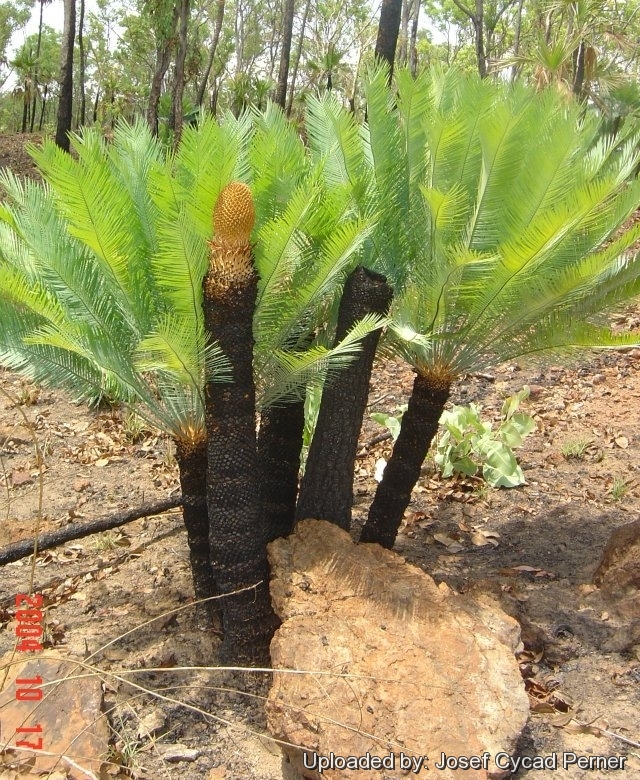
Cycas canalis Photo by: Josef Cycad Perner
Male cones.
Origin and Habitat: Cycas canalisSN|29958]]SN|29958]] is known from the Northern Territory, Australia. Populations are found in near-coastal sites at Channel Point to the mouth of the Daly River and this is apparently disjunct from inland occurrences that extend from west of Dorisvale to around Douglas Daly reserve. The overall population size is estimated to be at least 20,000 individuals and these appear to be stable
Habitat and Ecology: C. canalis grows on a variety of well-drained soil types, usually on lateritic soil profiles in open forest or woodland with Eucalyptus miniata. Plants near the coast grow in Eucalyptus woodland. C. canalis is threatened by habitat clearing for agriculture and tourist development. Frequent fire appears to be a threat to reproduction in the Channel Point population.
Synonyms:
See all synonyms of Cycas canalis
back
Accepted name in llifle Database:Cycas canalis K.D.HillTelopea 5: 698 1994Synonymy: 2
back
Common Names include:
ENGLISH: Bush palm
Description: Cycas canalis (bush palm) is a medium to tall palm-like cycad with slenderer woody trunk to about 5 m tall topped with a neat crown of blue-green, fronds, flat in section and arching out from the central trunk. It is distinguished by the densely orange-woolly or floccose cataphylls similar to that present in Cycas lanata and new leaves glaucous blue.
Derivation of specific name The epithet for Cycas canalis is Latin for canal or channel,
referring to this cycad’s occurrence at Channel Point, Northern Territory, Australia.
Stems: Erect, growing to about 3-5 m tall and 7-14 cm diameter.
Leaves: Pinnate, 60-105 cm long, blue-green fading to green, flat in section (opposing leaflets inserted at about 180° on rachis) or in a shallow 'v'-shape on either side of the leaf stem in subsp. carinata, with 100-170 leaflets; median leaflets at 50-90° to rachis, l0-20 cm long, 4.5-8 mm wide. The petioles are 15-25 cm long, and armed with sharp spines for most of their length.
Cataphylls: The cataphylls (Modified leaf, much reduced and thickened, serving to protect the apical meristem in cycads produced in flushes preceding the emergence of cones or leaves.) are
Male cones: Solitary, ovoid, l5-22 cm long, 8-11 cm in diameter, green to orange, the microsporophylls 35-45 mm long with an upturned apical spine.
Megasporophylls: Like other Cycas species, the female plants do not bear cones; instead they carry ovules and seeds on large, open, gray and orange tomentose megasporophylls which are pendent when mature, l6-25 cm long, with 2-4 ovules. The lamina is lanceolate, with spined dentate margins and an apical spine, sterile apex 40-60 mm long, 22-32 mm wide.
Subspecies, varieties, forms and cultivars of plants belonging to the Cycas canalis group
Bibliography: Major references and further lectures
1) Patrick M. McCarthy, Anthony E. Orchard.“Flora of Australia. Volume 48., Ferns, Gymnosperms and allied groups, Australian Biological Resources Study” Collingwood, Vic.: CSIRO, 1998.
2) Peter Drahos “Intellectual Property, Indigenous People and their Knowledge” Cambridge University Press, 12 June 2014
3) Ottley, H. 2010. Cycas canalis. The IUCN Red List of Threatened Species 2010: e.T42023A10628338. http://dx.doi.org/10.2305/IUCN.UK.2010-3.RLTS.T42023A10628338.en . Downloaded on 20 October 2015.
4) Whitelock, Loran M., "The Cycads", Timber press, 2002.
5) Haynes J.L, "World List of Cycads: A Historical Review", IUCN/SSC Cycad Specialist Group, 2012.
6) Wikipedia contributors. "Cycas canalis." Wikipedia, The Free Encyclopedia. Wikipedia, The Free Encyclopedia, 24 Dec. 2014. Web. 20 Oct. 2015.
7) The Cycad Pages “Cycas canalis” Royal Botanic Gardens Sydney Written and maintained by Ken Hill 1998-2010 Maintained by Leonie Stanberg and Dennis Stevenson 2010-2012 <http://plantnet.rbgsyd.nsw.gov.au/cgi-bin/cycadpg?taxname=Cycas+canalis> Web. 02 October 2015.
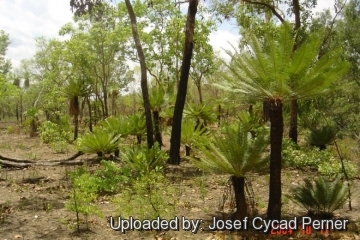 Cycas canalis Photo by: Josef Cycad Perner
Cycas canalis Photo by: Josef Cycad Perner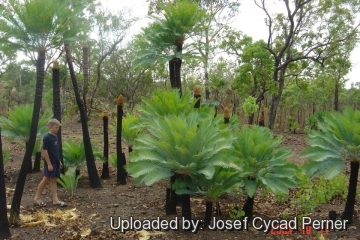 Male cones on the tall cycads at the back. Photo by: Josef Cycad Perner
Male cones on the tall cycads at the back. Photo by: Josef Cycad Perner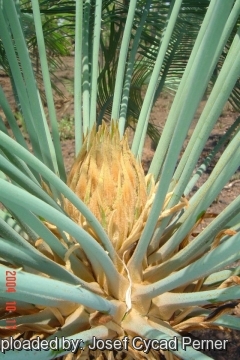 Female cone (developing) Photo by: Josef Cycad Perner
Female cone (developing) Photo by: Josef Cycad Perner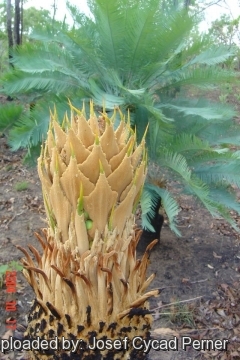 Female cone Photo by: Josef Cycad Perner
Female cone Photo by: Josef Cycad Perner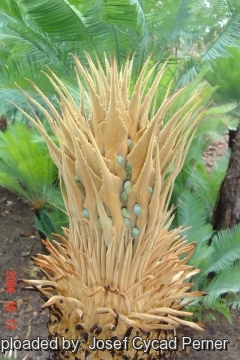 Female cone Photo by: Josef Cycad Perner
Female cone Photo by: Josef Cycad Perner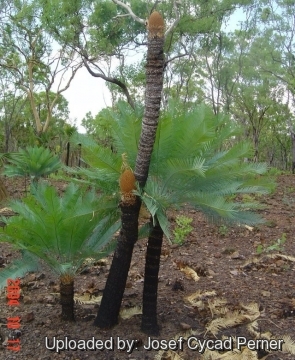 Male cones on the tall cycads. Photo by: Josef Cycad Perner
Male cones on the tall cycads. Photo by: Josef Cycad Perner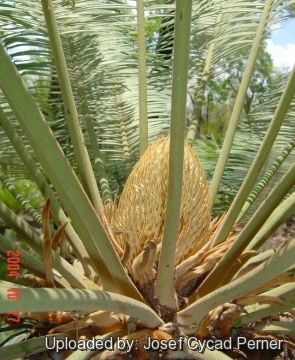 Male cones. Photo by: Josef Cycad Perner
Male cones. Photo by: Josef Cycad Perner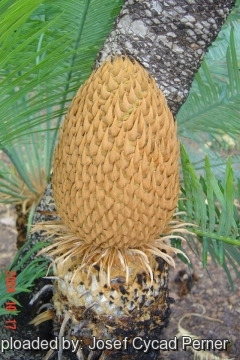 Male cones. Photo by: Josef Cycad Perner
Male cones. Photo by: Josef Cycad PernerCultivation and Propagation: Cycas canalisSN|29958]]SN|29958]] is suited to tropical regions which have a seasonally dry climate. It is easy to grow, tolerating dry periods, but up to the time of this writing this species is not common in cultivation. Cycas couttsianaSN|31952]]SN|31952]] has a nice appearance and may make a good garden or landscape planted in the ground or a deep pot so its fast-growing taproot room can develop properly. Benefits of this plant include high tolerance to sun, drought, heat and cold.
Growth rate: Usually slow growing, however good conditions can speed it up considerably. Because of its growth habit, fertilize only when terminal bud begins to swell, indicating the start of the annual growth cycle.
Exposure: It prefers bright light exposure; best with some protection from afternoon heat.
Soil: Needs a well drained spot, with deep soil, but will still thrive in less than ideal conditions.
Maintenance: Minimal; removal of offsets if desired, removal of spent fronds.
Use: Landscape as cultivated perennial in warm, coastal areas; House-plant or interior-scape, as container plant in cool areas, as well very well suited to bonsai culture.
Traditional uses: The seeds of Cycas canalisSN|29958]]SN|29958]] (bush palm) is poisonous, but can be turned into a damper that has the qualities of long-term storage and high food energy. The flour is used to make tortillas, tamales, soup and porridge. However, consumption of the flour may result in a neurological disorder because of the neurotoxins content.
Propagation: Seed or offshoots (or "pups"). The advantage of the "pups" is that you will know its sex, for seedlings you will have to wait several years until the plant flowers to find out. After fertile seeds are collected, they usually need several months of storage before the inner embryo is ready to germinate. Therefore, it is best to clean the seeds of external fruit and set them aside before attempting to propagate the seeds.
Your Photos

by Josef Cycad Perner


















